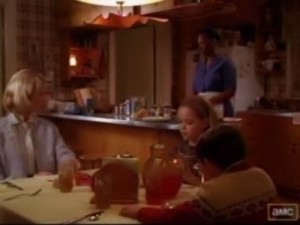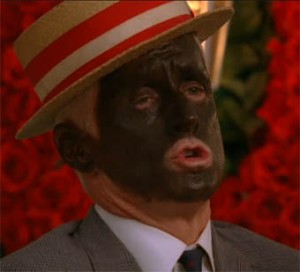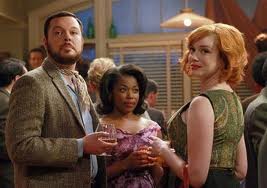In Defense of the Strategic Marginalization of Blackness within Mad Men
 The dearth of blacks in television programming is an old story. Season after season, watchdog groups cry foul as the broadcast and cable networks produce television shows without thinking about casting black actors. In many cases, the blacks who are cast function as filler—they walk across the screen and fill up space. Of course this lack of racial difference is a problem that needs to be addressed and not in the more pedantic measures that network executives have peddled, e.g., adding the “token” black to an already established white cast or the more recent process of blindcasting where race is not explicitly written into the casting breakdowns which grants non-white actors the possibility of employment. The problem with the latter is that the role is written as normatively white, thus cultural specificity is both lost and conflated with skin color. These are the systems at work in contemporary television programming which is why the title and purpose of this essay seem counterintuitive. Why in the world would anyone defend the strategic marginalization of blackness?
The dearth of blacks in television programming is an old story. Season after season, watchdog groups cry foul as the broadcast and cable networks produce television shows without thinking about casting black actors. In many cases, the blacks who are cast function as filler—they walk across the screen and fill up space. Of course this lack of racial difference is a problem that needs to be addressed and not in the more pedantic measures that network executives have peddled, e.g., adding the “token” black to an already established white cast or the more recent process of blindcasting where race is not explicitly written into the casting breakdowns which grants non-white actors the possibility of employment. The problem with the latter is that the role is written as normatively white, thus cultural specificity is both lost and conflated with skin color. These are the systems at work in contemporary television programming which is why the title and purpose of this essay seem counterintuitive. Why in the world would anyone defend the strategic marginalization of blackness?
I began to put together my thoughts on this issue in 2008 during Mad Men’s second season. Set in 1962, I had great hope for what this program could become. Two years later, this essay wrestles with those thoughts and the issues I incorrectly predicted.
 First, let me be clear: this is not a generalizable defense of all shows that exclude blacks. Mad Men is an exceptional case because of its very rigid time period and object of study: advertising agencies in 1960s America. In season two, several important events had yet to occur that would make my argument differ: JFK’s death and the election of Lyndon B. Johnson which eventually beget the Civil Rights Act of 1964. African-Americans in particular had yet to gain equality in the workplace. Thus, it made little sense to “see” blacks outside of the positions they dominated at this time. The black elevator operator, the black lunch lady, the black janitor, and the black maid represented the various types of minority presence on the show. Initially off-put by the exclusion, I reconsidered once I realized the show’s desire to recreate that America in all of its ugliness.
First, let me be clear: this is not a generalizable defense of all shows that exclude blacks. Mad Men is an exceptional case because of its very rigid time period and object of study: advertising agencies in 1960s America. In season two, several important events had yet to occur that would make my argument differ: JFK’s death and the election of Lyndon B. Johnson which eventually beget the Civil Rights Act of 1964. African-Americans in particular had yet to gain equality in the workplace. Thus, it made little sense to “see” blacks outside of the positions they dominated at this time. The black elevator operator, the black lunch lady, the black janitor, and the black maid represented the various types of minority presence on the show. Initially off-put by the exclusion, I reconsidered once I realized the show’s desire to recreate that America in all of its ugliness.
Unlike other recreations of this era — I am thinking particularly of Hairspray (2008) — Mad Men does not carry the same kind of “hindsight smugness”; that is, a show’s ability to re-interpret an era’s ideology through a contemporarily superior lens. For example, Hairspray‘s seemingly easy integration of blacks and whites overwhelmingly contains hindsight smugness. That film’s thesis posits that people can just get together regardless of racial backgrounds and dance but that is a 21st century belief and not a 1950s one. Conversely, Mad Men‘s strategic exclusion of blacks in key character roles works because integration had not occurred in the way it would in the late 1960s and 70s. To place a black man in the offices of Sterling Cooper would be more to comfort ourselves as contemporary audience members than to give a more accurate depiction of that overtly racist era.
 The future of race politics in American culture leads to my final point concerning the possible ways we can understand Mad Men‘s exclusion of blacks as central characters. Two years ago, I believed that as the show continued there would be African-American characters in key positions based on the steady increase of their presence in season two. And I was partially correct: season two found Paul Kinsey dating Sheila, the black grocery store clerk. While she only had two lines of dialogue, her presence was necessary to illustrate Kinsey’s superficial attempt at non-comformity and potentially brought Mad Men one step closer to negotiating racial conflict. As it is now, the show strategically places blacks and issues of blackness in the periphery—always present, always watching, always knowing the white characters think of them as invisible. However, is that enough? Is it enough to view the characters watching television’s coverage of Civil Rights? Is it enough that Betty dreams of Medgar Evers? At this point, blackness should not consist of a random black couple passing Don, as in last night’s episode. But maybe the answer speaks to a larger issue that queries if the show is imitating life or if life is imitating the show: what happens when a white showrunner and a staff of white writers review history through the eyes of characters who are wholly invested in white privilege? What does that suggest about the writers’ own privilege?
The future of race politics in American culture leads to my final point concerning the possible ways we can understand Mad Men‘s exclusion of blacks as central characters. Two years ago, I believed that as the show continued there would be African-American characters in key positions based on the steady increase of their presence in season two. And I was partially correct: season two found Paul Kinsey dating Sheila, the black grocery store clerk. While she only had two lines of dialogue, her presence was necessary to illustrate Kinsey’s superficial attempt at non-comformity and potentially brought Mad Men one step closer to negotiating racial conflict. As it is now, the show strategically places blacks and issues of blackness in the periphery—always present, always watching, always knowing the white characters think of them as invisible. However, is that enough? Is it enough to view the characters watching television’s coverage of Civil Rights? Is it enough that Betty dreams of Medgar Evers? At this point, blackness should not consist of a random black couple passing Don, as in last night’s episode. But maybe the answer speaks to a larger issue that queries if the show is imitating life or if life is imitating the show: what happens when a white showrunner and a staff of white writers review history through the eyes of characters who are wholly invested in white privilege? What does that suggest about the writers’ own privilege?
In closing, I still have hope that this strategic exclusion will pay off. But I have grave concerns that we will be satisfied with the nudges and winks at Don Draper’s world being turned upside down at the expense of a story about those who are doing the turning.



MAD MEN has flirted with the position of African Americans in ’60s America on several occasions and I keep expecting it to go deeper into that issue. It almost seems as if it’s holding back, that race is being repressed, but occasionally breaks through the surface.
It makes me wonder how MAD MEN could address ’60s racism. Would it make sense to explore the parallel worlds of black and white culture, to follow housekeeper Carla home?
Jeremy,
I have waited to see how Mad Men would explicitly address racism, period. Again, I think the show spends a great deal of tiime using the events of the period as historical context with occasional commentary from one or more of the characters. However, I honestly don’t believe that Weiner has figured out how or even if he wants to pursue racism on the show. Sexism, yes. Sexism against white women, yes. And that makes sense given that a large share of his writing staff are women–white women. I think I worry that the lack of color on the production side will yield a lack of story on the content side. I worry that these writers are already negotiating their “liberal white guilt” through the peripheral stories of Clay vs. Liston.
I think and have always thought that following Carla home would be a wonderful story. That we never truly know what Carla is thinking–that they never give her the opportunity to voice her thoughts–is sly but also cowardly.
While I agree that Mad Men’s authenticity is important to its core concept, and inserting a black character into the agency itself would be out of place, I have to wonder why the show can’t do for people of color what it’s done for women. Mad Men has done an extraordinary job, I think, of showing sexism without REPLICATING sexism — we see what Betty, Peggy, and Joan go through, and how they’re excluded from male spheres, but we see that from their perspective. They’re three-dimensional characters with conflicts of their own that don’t necessarily revolve around the male characters. And this despite the fact that Betty, at least, is not at all a part of the ad world
I can’t see why the show couldn’t do more for characters of color — follow Carla home, as Jeremy suggests, or explore the lives of the Japanese businessmen we met this season. It may be impossible to fully integrate those characters into the world of SCDP, but the show has become much more than SCDP.
(On another inclusiveness note, I’m still bitter about Sal’s exit. While a gay man getting fired because of his sexuality in the 1960s is completely authentic, by relying on “authenticity” as an excuse for writing him out of the show, as Wiener has done in interviews, the show is replicating that very injustice — firing an openly gay actor. Could we not have seen his path past Sterling Cooper?)
Jennifer,
Authenticity is a tricky word that I tried very carefully to avoid. I’m walking a fine line with it too because I’m suggesting that accuracy is a key structuring factor in determining the ways that blacks appear in the show. However, I think that what is so key about Mad Men is that it is recreated history through one man’s eyes. The world of advertising in 1960s America through Don Draper’s eyes. Because Draper has no connection to blackness (Carla, I think functions as an object rather than a subject to Don and to Betty), it’s not something that he would give much attention to. Now, women? And, specifically white women? They surround him daily. Thus it makes sense that they would have dimensionality and depth in their roles. White women’s struggles and formation in the feminist movement are well-documented and serve as the official record. But not black womanhood. Betty, while not connected to the ad world (at least not any more…remember, she was a model before she married Don), is still tied to the program because of Don. And, if you notice, this season she’s not in as many episodes precisely because she is no longer married to Don.
From a production standpoint, again, if half your writing staff are white women, then that clearly shapes the output. If all your staff are white, then that clearly shapes the output. Thus, I wholeheartedly agree with you that in 1965 there clearly should be a way that people of color can have some entry onto the very white world of SCDP (Carla would be a breathtakingly amazing narrative they should have begun a long time ago); but I disagree that the world is any less about SCDP, the great metaphor for white privilege, where its members do not have to deal with racial and cultural difference.
Kristen,
You’re right that you avoided the word authenticity, and I apologize for implying otherwise. I think I brought it up because it seems to be the shield Wiener uses to defend himself against criticisms about the lack of diversity, and that opens a bigger can of worms.
I agree that the makeup of the writing staff probably has quite a bit to do with the kinds of stories that are told, but I’m not sure it’s an excuse — an explanation, certainly, but not a way to avoid responsibility.
I also disagree that the show is entirely constructed through Don’s eyes. From the first episode Peggy, at least, has provided a counterbalancing perspective, acting as a second protagonist through much of the series and showing us glimpses of a world (of Catholicism, family, etc.) that have nothing to do with Don. And her world, as we’ve seen this season as she’s made new friends, continues to expand beyond the ad agency. Even the secondary characters, like Joan and Pete, have home lives that Don isn’t privy to, so Don’s obliviousness and privilege can’t be the only reason we only see select views of the world outside the office. The ad agency is clearly central to the stories Weiner is telling, but the show has proven on many occasions that it can go beyond that, and I can’t help wishing that its visits to the world outside were a bit more diverse.
(Sorry for not threading properly! And because I forgot to say it before, thank you for writing this post — whatever the perspective, this is a topic that deserves discussion, and you make your points eloquently.)
[…] Kristen at Dear Black Woman, wrote a provocative essay for Antenna about the show’s strategic marginalization of black people wherein much of her pleasure in reception seems to derive from an unfulfilled hope that people of […]